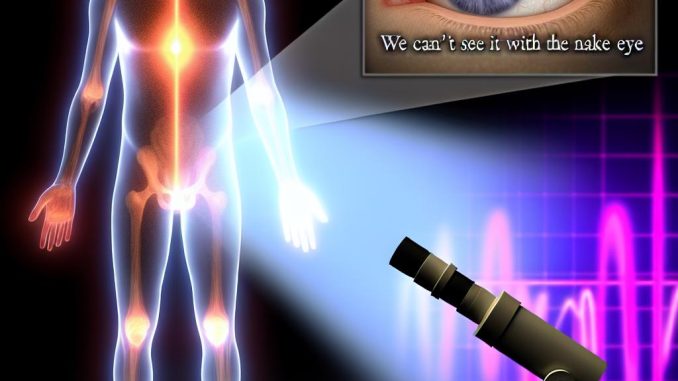
The Phenomenon of Biophoton Emission
The intricate workings of the human body remain a subject of fascination and continuous exploration. Beyond its complex systems and enduring mysteries, the body offers a subtle, yet captivating, display of light emission known as biophoton emission. Though this phenomenon escapes the realm of direct perception due to its faintness, it piques scientific interest and holds promise for groundbreaking insights into our biological and physiological states.
Understanding Biophotons
Biophotons represent tiny particles of light emitted by biological living cells. These weak light emissions are primarily a byproduct of oxidative reactions within cellular metabolism. In essence, as cells metabolize nutrients to release energy, they generate free radicals—reactive molecules that can occasionally decompose, releasing photons in the process. Such light, albeit minuscule, is part of a fascinating biological dance that holds clues about cellular activities and health.
The Science Behind Invisibility
Despite the fact that biophotons equate to particles of light, their visibility to human eyes remains elusive. The inherent limitation stems from their extremely low intensity, ranging from 100 to 1,000 times less than what human vision can typically detect. As a result, specialized equipment becomes imperative in capturing these novel emissions. Use of devices such as photomultipliers and charge-coupled device (CCD) cameras, designed specifically for low-light sensitivity, allows scientists to observe and measure these subtle signals.
Potential Implications and Research
The research surrounding biophoton emissions involves more than mere curiosity, with significant potential implications looming on the horizon. Scientists are scrutinizing the light emissions for telltale patterns or intensities that could reflect physiological conditions or health states. For instance, anomalies in biophoton patterns might act as biomarkers for diseases, such as cancer, offering a non-invasive diagnostic pathway. This pursuit drives the development of imaging technologies finely tuned to detect faint emissive cues, potentially refining medical diagnostics and expanding the understanding of cellular health.
Further Exploration
The exploration of biophotons extends to broader scientific endeavors, notably within bioenergetics, where the focus lies on the synthesis, transformation, and utilization of energy within living systems. By decoding these processes, researchers aim to unravel new dimensions of cellular energy management. Furthermore, biophoton emissions could illuminate aspects of intra- and inter-cellular communication, positing them as silent communicative signals within biological systems. These emissive particles may also intersect with investigations into the regulation of biological rhythms, underscoring their potential roles in orchestrating complex life processes.
In pursuit of deeper knowledge, a plethora of scientific studies and comprehensive reviews untangle the nuances of biophoton emissions. Scientists worldwide allocate resources to unravel the mysteries held within these light emissions, anticipating advances in cellular function comprehension. Emerging technologies in fields like biophotonics open promising avenues to capture and scrutinize these elusive signals, broadening the scope of available analyses.
Whilst reminiscences of glowing science fiction characters may conjure intrigue, the reality underpinning biophoton emission firmly anchors in cellular metabolic realities. As research into these tiny light signals progresses, unearthing their secrets may illuminate innovative pathways within the domains of medicine and biology. Such advancements foreshadow transformative discoveries, promising to further our grasp of human health and cellular dynamics.
The ongoing inquiry into biophoton emissions fosters a fertile ground for hopes and expectations. Expanding our understanding of this illumined biological phenomenon beckons towards insights that could redefine diagnostics and revolutionize our perception of cellular ecosystems. As the frontier of biophoton research unfolds, the resulting knowledge stands to shine a new light, creating a bridge between unseeable cellular whispers and their tangible impacts on health science.
In conclusion, the study of biophoton emission underscores an exciting and largely untapped frontier within scientific exploration. Unraveling the intricacies of these faint light signals affords a captivating glimpse into cellular behavior and offers a potential diagnostic lens. As researchers delve deeper into the subtle language of light emissions, the possibilities for breakthroughs in biological and medical fields continue to expand, promising novel insights into the unseen yet illuminating aspects of life’s cellular tapestry.
